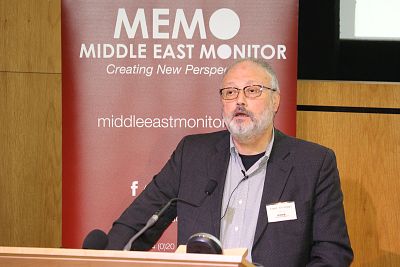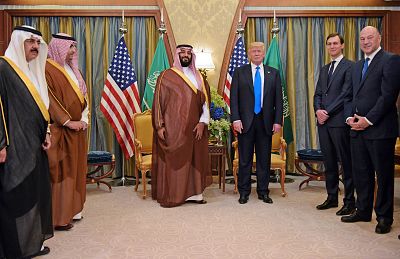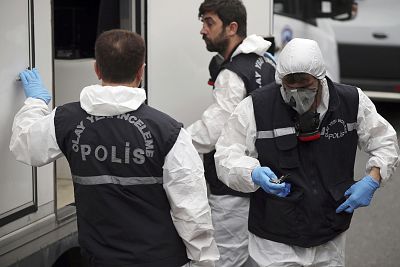Saudi officials say their team was supposed to negotiate with Khashoggi, and if he didn't agree to return to Saudi Arabia, take him to a safe house.
WASHINGTON — The 15-man team sent by Saudi intelligence to Istanbul planned to hold Jamal Khashoggiagainst his will for up to two days in a safe house in Turkey while persuading him to return to his home country, Saudi officials said, adding another element to the kingdom's evolving explanation about the journalist's killing.
Although Saudi Arabia has acknowledged that its operatives killed Khashoggi, it has maintained that the goal was not to kill him but to bring him back to Saudi Arabia, and that the exfiltration turned violent when Khashoggi resisted, leading to a fatal fistfight or strangulation. Turkish authorities have steadfastly disputed that account, with President Recep Tayyip Erdogan using a major speech Tuesday to say Turkey believes Khashoggi's murder was "premeditated."
"We have strong signs that this murder did not stem from a momentary incident, but it is rather a planned operation," Erdogan said in Turkish.
But multiple Saudi officials tell NBC News that the structure of the botched operation demonstrates that the objective wasn't to kill Khashoggi. They said an internal Saudi investigation has revealed that the 15-man crew was divided into three teams, with some assigned to overall logistics and security and a special team dedicated to interrogating Khashoggi in the consulate. Of the 15 Saudis, only nine were inside the consulate at the time of the killing, they said.
The Saudi officials said that the investigation had unearthed an internal tasking order to the team that said they were to negotiate with him inside the consulate. If he didn't immediately agree to return to Saudi Arabia, the team was to bring him to a safehouse elsewhere in the Istanbul area and continue to negotiate. If he still refused after two days, he would be released, the officials said.
The officials did not provide any evidence to corroborate that account. Nor was it clear how the Saudis could have expected that after kidnapping Khashoggi for two days, they could release him without fear that he would immediately report what had happened to Turkish authorities or the media. The possibility that the team might hold Khashoggi in a safehouse was first reported by Reuters, which cited one Saudi official.
"The idea that the Saudis would take him outside of their own diplomatic compound, into sovereign Turkish territory and apply pressure to him is just completely implausible," said Amy Hawthorne of the Washington-based Project on Middle East Democracy. "It's incredibly difficult to take at face value anything the Saudi government is saying about this episode."
Since acknowledging Friday that Khashoggi was killed in the consulate, Saudi Arabia's government has struggled to explain why an autopsy and forensics expert was part of the team if there was no plan to kill Khashoggi. The Saudi officials now tell NBC News that the forensics expert, identified by Turkish authorities as Dr. Salah Muhammed al-Tubaigy, was dispatched to ensure that any forensics evidence linking Khashoggi to the safehouse was eliminated after he was either released or returned to Saudi Arabia.
Khashoggi never made it to any safehouse. Citing accounts provided by the suspects during the internal Saudi investigation, officials said that after killing him in the consulate, the Saudi team removed his body from the consulate rolled up in a rug. Then Khashoggi's body was given to a "local collaborator" who disposed of it at an unknown location, the officials said, reiterating an earlier account given to Reuters.
"Now I am asking, who is this local cooperator?" Erdogan asked in his speech Tuesday. "If that's the case, you are obliged to reveal this local cooperator. You will reveal him. Without these questions being answered, nobody should think the issue will be closed."
Turkish authorities have been searching multiple locations in the Istanbul area, but so far have not announced that they have found or identified a body.
The continually evolving explanation from the Saudis — who insisted for weeks Khashoggi had left the consulate before finally conceding he was murdered inside — has fueled growing frustration for the Trump administration, Congress and foreign governments, including Turkey.
But Saudi officials say that once they learned Khashoggi had not in fact left the consulate, they stopped commenting publicly to allow an investigation to proceed. Since the investigation revealed that Khashoggi had been killed, the officials said Saudi authorities have tried to be forthcoming and have been providing information as it's uncovered. They said new pieces of the story subsequently revealed have sought to clarify or add more detail to what was previously known rather that to alter their previous explanation.
One consistent element in the Saudi explanation is the insistence that Crown Prince Mohammed bin Salman was unaware, despite the involvement of some of his top aides. Saudi Foreign Minister Adel al-Jubeir told Fox News on Sunday that it was a "rogue operation" in which the Saudi operatives exceeded their authority.
"This was an operation where individuals ended up exceeding the authorities and responsibilities they had," Jubeir said. "They made the mistake when they killed Jamal Khashoggi in the Consulate, and they tried to cover up for it."
But U.S. officials have told NBC News that American intelligence agencies believe it's inconceivable that the crown prince had no connection to Khashoggi's death, although they lack "smoking gun" evidence of his involvement.
The Saudi officials pointed to a longstanding Saudi government directive as the source of the misunderstanding or breach of authority. The directive broadly states that the Saudi government should conduct negotiations to try to bring dissidents who have left Saudi Arabia back to the country for reconciliation and re-integration into society, the officials said. Other individuals with knowledge of the directive have confirmed its existence to NBC News.
The Saudi government has blamed a senior Royal Court adviser and the deputy intelligence chief for going beyond the directive's scope by planning and executing an operation in which Khashoggi was to be kidnapped and was ultimately killed. Both officials have been fired.














